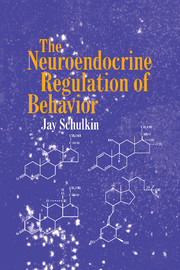Book contents
- Frontmatter
- Contents
- Acknowledgments
- Introduction
- 1 Hormones, Development, and Sexual Dimorphic Behaviors
- 2 Hormonal Regulation of Sodium and Water Ingestion
- 3 Hormonal Regulation of Food Selection
- 4 Hormones, Parental Care, and Attachment Behaviors
- 5 Hormonal Regulation of Fear and Stress
- 6 Hormones, Behavior, and Biological Clocks
- Conclusion
- References
- Name Index
- Subject Index
2 - Hormonal Regulation of Sodium and Water Ingestion
Published online by Cambridge University Press: 25 January 2011
- Frontmatter
- Contents
- Acknowledgments
- Introduction
- 1 Hormones, Development, and Sexual Dimorphic Behaviors
- 2 Hormonal Regulation of Sodium and Water Ingestion
- 3 Hormonal Regulation of Food Selection
- 4 Hormones, Parental Care, and Attachment Behaviors
- 5 Hormonal Regulation of Fear and Stress
- 6 Hormones, Behavior, and Biological Clocks
- Conclusion
- References
- Name Index
- Subject Index
Summary
Introduction
In what follows we shall review the hormonal control of water and sodium appetite. The greatest emphasis will be on sodium ingestion, for it reflects my own research interests. The first major section is on angiotensin-induced water and sodium appetite, with discussion of the sites of action. The second major section discusses corticosteroid-induced sodium appetite and the sites of action. The third major section deals with stress-induced (or corticotropin-releasing-hormone- and corticosterone-induced) sodium intake and the sites of action. The fourth major section concerns angiotensin- and corticosteroid-induced water and sodium appetite and the sites of action. The fifth section deals with atrial natriuretic peptide and inhibition of water and sodium ingestion. The final section depicts an anatomic circuit that may underlie the cravings for water and sodium.
Sodium Hunger
Sodium appetite, in addition to thirst, provides the backbone of extracellular fluid regulation at a behavioral level of analysis. It has been known since the turn of the century that loss of extracellular fluid can generate thirst; it occurs when one bleeds or sweats under natural circumstances (Fitzsimons, 1979; Denton, McKinley, and Weisinger, 1996). Later it was discovered that sodium hunger is also expressed under these conditions (Wolf, 1969b; Denton, 1982). The hormones that regulate extracellular fluid balance have been preserved across evolution in terrestrial vertebrates (Denton, 1965). Sodium ingestion is linked to extracellular fluid balance. Thus the hunger for sodium provides a window into extracellular fluid regulation (Denton, 1982).
- Type
- Chapter
- Information
- The Neuroendocrine Regulation of Behavior , pp. 53 - 84Publisher: Cambridge University PressPrint publication year: 1998



